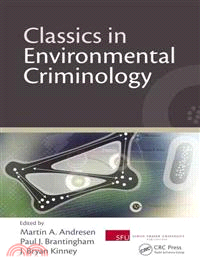Classics in Environmental Criminology
商品資訊
ISBN13:9781439817797
出版社:CRC Press UK
作者:Martin A. Andresen (EDT); Paul J. Brantingham (EDT); J. Bryan Kinney (EDT)
出版日:2010/05/25
裝訂/頁數:精裝/551頁
規格:23.5cm*15.9cm*3.2cm (高/寬/厚)
版次:1
定價
:NT$ 7800 元優惠價
:90 折 7020 元
若需訂購本書,請電洽客服 02-25006600[分機130、131]。
商品簡介
作者簡介
目次
相關商品
商品簡介
A careful analysis of environmental factors is key to understanding the causes of crime, to solving crimes, and eventually helping to predict and prevent them. Classics in Environmental Criminology is a comprehensive collection of seminal pieces from legendary contributors who focus on the role that the immediate environment plays in the occurrence of a crime.
Defines the field
Divided into three parts, the book begins by highlighting the development of environmental criminology as a discipline through its origins in spatial criminology. It examines social disorganization theory, which explains criminal activity with reference to the characteristics of the community that delinquents live in. It then discusses the ecology of crime with reference to macroenvironments and microenvironments. The next section introduces concepts such as routine activity theory, the geometric theory of crime, the rational choice theory of offending, and crime pattern theory.
Offers perspectives on prevention
The last part focuses on the concept of crime prevention, examines the idea of altering the environment in order to prevent crime, and discusses situational crime factors and efforts to reduce the opportunities for crimes to be committed. It considers the impact of routine activities on crime prevention initiatives and advocates a flexible approach to crime prevention based on the dynamic nature of our environment. The book concludes with a chapter outlining how environmental criminology has evolved in recent years and provides a future outlook on where it may be headed.
Invaluable as a textbook and as a professional reference, this volume is a comprehensive survey of a critical field in contemporary criminological theory. Offering insight assembled by top academic figures within the criminology community, this work is destined to provoke further inquiry and research.
Defines the field
Divided into three parts, the book begins by highlighting the development of environmental criminology as a discipline through its origins in spatial criminology. It examines social disorganization theory, which explains criminal activity with reference to the characteristics of the community that delinquents live in. It then discusses the ecology of crime with reference to macroenvironments and microenvironments. The next section introduces concepts such as routine activity theory, the geometric theory of crime, the rational choice theory of offending, and crime pattern theory.
Offers perspectives on prevention
The last part focuses on the concept of crime prevention, examines the idea of altering the environment in order to prevent crime, and discusses situational crime factors and efforts to reduce the opportunities for crimes to be committed. It considers the impact of routine activities on crime prevention initiatives and advocates a flexible approach to crime prevention based on the dynamic nature of our environment. The book concludes with a chapter outlining how environmental criminology has evolved in recent years and provides a future outlook on where it may be headed.
Invaluable as a textbook and as a professional reference, this volume is a comprehensive survey of a critical field in contemporary criminological theory. Offering insight assembled by top academic figures within the criminology community, this work is destined to provoke further inquiry and research.
作者簡介
Martin A. Andresen is an Assistant Professor at Simon Fraser University School of Criminology. His areas of interest are spatial crime analysis, geography of crime, environmental criminology, applied spatial statistics and geographical information analysis, and (critical) quantitative methods.
Paul J. Brantingham is a Professor at Simon Fraser University School of Criminology. His areas of interest are computational criminology, environmental criminology, the ecology of crime, crime analysis, historical criminology, comparative criminal justice, legal aid, and related matters.
J. Bryan Kinney is an Assistant Professor at Simon Fraser University School of Criminology. His areas of interest are environmental criminology theory, geography of crime, police studies, crime prevention and crime reduction, and quantitative research methods.
Paul J. Brantingham is a Professor at Simon Fraser University School of Criminology. His areas of interest are computational criminology, environmental criminology, the ecology of crime, crime analysis, historical criminology, comparative criminal justice, legal aid, and related matters.
J. Bryan Kinney is an Assistant Professor at Simon Fraser University School of Criminology. His areas of interest are environmental criminology theory, geography of crime, police studies, crime prevention and crime reduction, and quantitative research methods.
目次
Early Work on the Ecology of CrimeThe Place of Environmental Criminology within Criminological Thought; M.A. AndresenOf the Development of the Propensity to Crime (1842); L.A.J. QueteletLocalities of Crime in Suffolk (1856); J. GlydeJuvenile Delinquency in a Small City (1916); E.W. BurgessJuvenile Delinquency and Urban Areas: A Study of Rates of Delinquency in Relation to Differential Characteristics of Local Communities in American Cities (1969); C.R. Shaw and H.D. McKayUrban Ecological Aspects of Crime in Akron (1974); G.F. Pyle, E.W. Hanten, P.G. Williams, A.L. Pearson II, J.G. Doyle, and K. KwofieIntraurban Crime Patterns (1974); K.D. HarriesClassics in Environmental CriminologySocial Change and Crime Rate Trends: A Routine Activity Approach (1979); L.E. Cohen and M. FelsonRoutine Activities and Crime: An Analysis of Victimization in Canada (1990); L.W. Kennedy and D.R. FordeNotes on the Geometry of Crime (1981); P.L. Brantingham and P.J. BrantinghamThe Use of Space in Burglary (1985); G.F. Rengert and J. WasilchickNodes, Paths, and Edges: Considerations on the Complexity of Crime and the Physical Environment (1993); P.L. Brantingham and P.J. BrantinghamModeling Offenders’ Decisions: A Framework for Research and Policy (1985); R.V. Clarke and D.B. CornishLinking Criminal Choices, Routine Activities, Informal Control, and Criminal Outcomes (1986); M. FelsonUnderstanding Crime Displacement: An Application of Rational Choice Theory (1987); D.B. Cornish and R.V.G. ClarkeEnvironment, Routine, and Situation: Toward a Pattern Theory of Crime (1993); P.L. Brantingham and P.J. BrantinghamEnvironmental Criminology and Crime PreventionA Conceptual Model of Crime Prevention (1976); P.J. Brantingham and F.L. FaustCrime Prevention and Control through Environmental Engineering (1969); C.R. JefferyCriminal Behavior and the Physical Environment: A Perspective; C.R. JefferySituational Crime Prevention: Theory and Practice; R.V.G. ClarkeRoutine Activities and Crime Prevention in the Developing Metropolis (1987); M. FelsonFuture Spaces: Classics in Environmental Criminology—Where Do We Go from Here? B. KinneyReferencesIndex
主題書展
更多
主題書展
更多書展今日66折
您曾經瀏覽過的商品
購物須知
外文書商品之書封,為出版社提供之樣本。實際出貨商品,以出版社所提供之現有版本為主。部份書籍,因出版社供應狀況特殊,匯率將依實際狀況做調整。
無庫存之商品,在您完成訂單程序之後,將以空運的方式為你下單調貨。為了縮短等待的時間,建議您將外文書與其他商品分開下單,以獲得最快的取貨速度,平均調貨時間為1~2個月。
為了保護您的權益,「三民網路書店」提供會員七日商品鑑賞期(收到商品為起始日)。
若要辦理退貨,請在商品鑑賞期內寄回,且商品必須是全新狀態與完整包裝(商品、附件、發票、隨貨贈品等)否則恕不接受退貨。
























